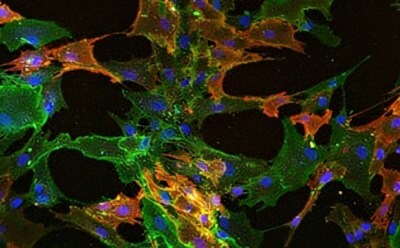干细胞培养

干细胞具有独特的自我更新能力或响应相关信号而分化为各种细胞的能力。这些特性为干细胞提供了独特的组织修复、置换和再生能力,使其成为再生医学和干细胞疗法中的重要研究工具。
干细胞的类型和特点
- 它们具有无限制自我更新的能力
- 它们是具有非专业化功能的非分化细胞
- 它们可在正确的条件下分化成特定的细胞类型干细胞已被广泛表征为专能或多能干细胞。
相关技术文章
- FAQs and information about IPS Cells or induced pluripotent stem cells (iPSCs). Including what are IPS cells, learning stem cell basics, reprogramming methods, and iPS cell culture techniques.
- Mouse embryonic fibroblasts (MEFs) serve as a feeder layer for both mouse and human embryonic stem cells (ES cells) and induced pluripotent stem cells (iPSCs).
- We offer a large collection of cell culture media, supplements, bioactive small molecules, and growth factors used to control the cell fate of human iPSCs.
- Read types of stem cells including multipotent stem cells, Pluripotent stem cells and iPSCs and their applications in basic stem cell research, stem cell therapy and disease modelling
- This white paper illustrates the importance of three-dimensional (3D) cell culture in the production of pluripotent stem cell (PSC)-derived models of embryo development and differentiation. It contains a general overview of embryoid bodies (EBs) and a comparison between the various methods used for their generation.
- 查看完整内容 (29)
相关实验方案
- Information about mesenchyme, specifically mesenchymal stem cell procotols. Step-by-step cell culture protocols for mesenchymal stem cell (MSC) isolation, expansion and differentiation.
- Step-by-step stem cell culture protocols for human induced pluripotent stem cells (iPSCs) including ips cell thawing, expanding, freezing and characterizing.
- Step-by-step culture protocols for neural stem cell culture including NSC isolation, expansion, differentiation and characterization.
- Stem Cell protocols for cryopreservation, thawing of cryopreserved stem cells and media preparation.
- Step-by-step hematopoietic stem cell culture protocols for isolation, expansion and differentiation of CD34+ hematopoietic progenitor cells including CFU assays. It can be cultured under defined conditions designed either to promote self-renewal and increase the number of primitive cells.
- 查看完整内容 (10)

专能干细胞包括可自我更新或分化成专门、组织特异性细胞类型的成年干细胞。它们包括可分化为多种血细胞的造血干细胞(HSC);可分化为成骨细胞、心肌细胞、软骨细胞和脂肪细胞的间充质干细胞(MSC);以及可分化为神经元、星形胶质细胞和少突胶质细胞的神经干细胞(NSC)。
多能干细胞可分化成任何细胞品系。根据组织来源可将它们分为胚胎干细胞(ESC)、围产期干细胞和诱导多能干细胞(iPSC)。其中,ESC来源于胚胎,可在体内干细胞培养中进行无限制地分裂。围产期干细胞来源于脐带或胎盘血或组织,是使用最广泛的多能干细胞。出生时进行脐带血储存已越来越被接受成为一种用于治疗生命后期复杂疾病的选择。iPSC是经重编码或诱导后可表现出类似于ESC特性的成年细胞。将iPSC用于医疗应用的显著优势在于降低了移植排斥的概率,因为这些细胞均来自患者自身的组织。
干细胞研究应用
凭借自我更新并分化成成熟细胞类型的能力,干细胞成为基础科学和临床研究中一个活跃且不断发展的领域。干细胞的现有临床应用包括神经和心血管疾病治疗方案、自身免疫疾病、癌症、伤口愈合、疾病建模和药物筛选。CRISPR等新发现的基因编辑技术可能会促进干细胞的研究,并为治疗困难疾病提供广阔的前景。
干细胞培养基础知识
干细胞需要专门的高品质培养基和专家级培养技术才能在实验室中进行培养。次优的干细胞培养条件会很容易导致干细胞的意外分化或细胞衰老。干细胞分化是由多种体内因子触发的,其中一些因子可在体外干细胞培养物中进行复制。某些干细胞系是永生化的,可以无限制地进行培养,因此必须为您的研究应用选择正确的干细胞类型。
干细胞领域的近期进展得益于CRISPR基因组编辑技术和3D细胞培养技术的出现。先进的实验方案(如从iPSC产生类器官)为科学家们提供了更具预测性的体外“皿中疾病”模型。
若要繼續閱讀,請登入或建立帳戶。
還沒有帳戶?